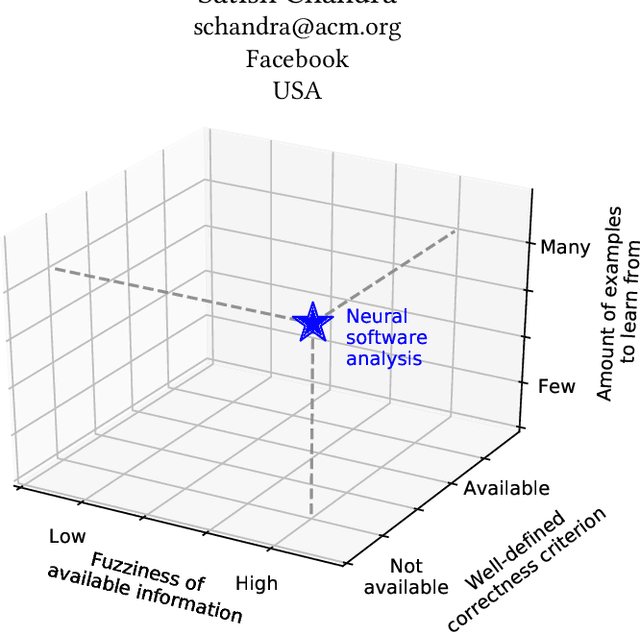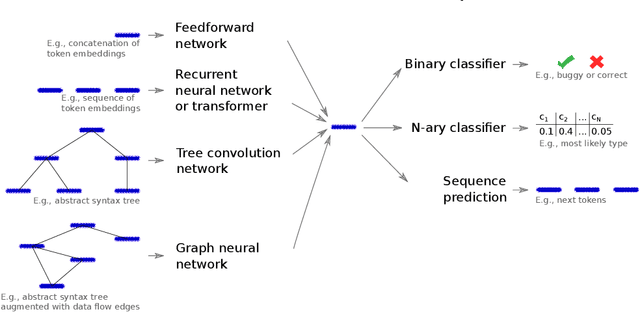Satish Chandra
Towards Verified Code Reasoning by LLMs
Sep 30, 2025Abstract:While LLM-based agents are able to tackle a wide variety of code reasoning questions, the answers are not always correct. This prevents the agent from being useful in situations where high precision is desired: (1) helping a software engineer understand a new code base, (2) helping a software engineer during code review sessions, and (3) ensuring that the code generated by an automated code generation system meets certain requirements (e.g. fixes a bug, improves readability, implements a feature). As a result of this lack of trustworthiness, the agent's answers need to be manually verified before they can be trusted. Manually confirming responses from a code reasoning agent requires human effort and can result in slower developer productivity, which weakens the assistance benefits of the agent. In this paper, we describe a method to automatically validate the answers provided by a code reasoning agent by verifying its reasoning steps. At a very high level, the method consists of extracting a formal representation of the agent's response and, subsequently, using formal verification and program analysis tools to verify the agent's reasoning steps. We applied this approach to a benchmark set of 20 uninitialized variable errors detected by sanitizers and 20 program equivalence queries. For the uninitialized variable errors, the formal verification step was able to validate the agent's reasoning on 13/20 examples, and for the program equivalence queries, the formal verification step successfully caught 6/8 incorrect judgments made by the agent.
Prompting LLMs for Code Editing: Struggles and Remedies
Apr 28, 2025Abstract:Large Language Models (LLMs) are rapidly transforming software engineering, with coding assistants embedded in an IDE becoming increasingly prevalent. While research has focused on improving the tools and understanding developer perceptions, a critical gap exists in understanding how developers actually use these tools in their daily workflows, and, crucially, where they struggle. This paper addresses part of this gap through a multi-phased investigation of developer interactions with an LLM-powered code editing and transformation feature, Transform Code, in an IDE widely used at Google. First, we analyze telemetry logs of the feature usage, revealing that frequent re-prompting can be an indicator of developer struggles with using Transform Code. Second, we conduct a qualitative analysis of unsatisfactory requests, identifying five key categories of information often missing from developer prompts. Finally, based on these findings, we propose and evaluate a tool, AutoPrompter, for automatically improving prompts by inferring missing information from the surrounding code context, leading to a 27% improvement in edit correctness on our test set.
Agentic Bug Reproduction for Effective Automated Program Repair at Google
Feb 03, 2025



Abstract:Bug reports often lack sufficient detail for developers to reproduce and fix the underlying defects. Bug Reproduction Tests (BRTs), tests that fail when the bug is present and pass when it has been resolved, are crucial for debugging, but they are rarely included in bug reports, both in open-source and in industrial settings. Thus, automatically generating BRTs from bug reports has the potential to accelerate the debugging process and lower time to repair. This paper investigates automated BRT generation within an industry setting, specifically at Google, focusing on the challenges of a large-scale, proprietary codebase and considering real-world industry bugs extracted from Google's internal issue tracker. We adapt and evaluate a state-of-the-art BRT generation technique, LIBRO, and present our agent-based approach, BRT Agent, which makes use of a fine-tuned Large Language Model (LLM) for code editing. Our BRT Agent significantly outperforms LIBRO, achieving a 28% plausible BRT generation rate, compared to 10% by LIBRO, on 80 human-reported bugs from Google's internal issue tracker. We further investigate the practical value of generated BRTs by integrating them with an Automated Program Repair (APR) system at Google. Our results show that providing BRTs to the APR system results in 30% more bugs with plausible fixes. Additionally, we introduce Ensemble Pass Rate (EPR), a metric which leverages the generated BRTs to select the most promising fixes from all fixes generated by APR system. Our evaluation on EPR for Top-K and threshold-based fix selections demonstrates promising results and trade-offs. For example, EPR correctly selects a plausible fix from a pool of 20 candidates in 70% of cases, based on its top-1 ranking.
Evaluating Agent-based Program Repair at Google
Jan 13, 2025Abstract:Agent-based program repair offers to automatically resolve complex bugs end-to-end by combining the planning, tool use, and code generation abilities of modern LLMs. Recent work has explored the use of agent-based repair approaches on the popular open-source SWE-Bench, a collection of bugs from highly-rated GitHub Python projects. In addition, various agentic approaches such as SWE-Agent have been proposed to solve bugs in this benchmark. This paper explores the viability of using an agentic approach to address bugs in an enterprise context. To investigate this, we curate an evaluation set of 178 bugs drawn from Google's issue tracking system. This dataset spans both human-reported (78) and machine-reported bugs (100). To establish a repair performance baseline on this benchmark, we implement Passerine, an agent similar in spirit to SWE-Agent that can work within Google's development environment. We show that with 20 trajectory samples and Gemini 1.5 Pro, Passerine can produce a patch that passes bug tests (i.e., plausible) for 73% of machine-reported and 25.6% of human-reported bugs in our evaluation set. After manual examination, we found that 43% of machine-reported bugs and 17.9% of human-reported bugs have at least one patch that is semantically equivalent to the ground-truth patch. These results establish a baseline on an industrially relevant benchmark, which as we show, contains bugs drawn from a different distribution -- in terms of language diversity, size, and spread of changes, etc. -- compared to those in the popular SWE-Bench dataset.
Natural Language Outlines for Code: Literate Programming in the LLM Era
Aug 09, 2024



Abstract:We propose using natural language outlines as a novel modality and interaction surface for providing AI assistance to developers throughout the software development process. An NL outline for a code function comprises multiple statements written in concise prose, which partition the code and summarize its main ideas in the style of literate programming. Crucially, we find that modern LLMs can generate accurate and high-quality NL outlines in practice. Moreover, NL outlines enable a bidirectional sync between code and NL, allowing changes in one to be automatically reflected in the other. We discuss many use cases for NL outlines: they can accelerate understanding and navigation of code and diffs, simplify code maintenance, augment code search, steer code generation, and more. We then propose and compare multiple LLM prompting techniques for generating outlines and ask professional developers to judge outline quality. Finally, we present two case studies applying NL outlines toward code review and the difficult task of malware detection.
Counterfactual Explanations for Models of Code
Nov 10, 2021


Abstract:Machine learning (ML) models play an increasingly prevalent role in many software engineering tasks. However, because most models are now powered by opaque deep neural networks, it can be difficult for developers to understand why the model came to a certain conclusion and how to act upon the model's prediction. Motivated by this problem, this paper explores counterfactual explanations for models of source code. Such counterfactual explanations constitute minimal changes to the source code under which the model "changes its mind". We integrate counterfactual explanation generation to models of source code in a real-world setting. We describe considerations that impact both the ability to find realistic and plausible counterfactual explanations, as well as the usefulness of such explanation to the user of the model. In a series of experiments we investigate the efficacy of our approach on three different models, each based on a BERT-like architecture operating over source code.
Neural Software Analysis
Nov 16, 2020



Abstract:Many software development problems can be addressed by program analysis tools, which traditionally are based on precise, logical reasoning and heuristics to ensure that the tools are practical. Recent work has shown tremendous success through an alternative way of creating developer tools, which we call neural software analysis. The key idea is to train a neural machine learning model on numerous code examples, which, once trained, makes predictions about previously unseen code. In contrast to traditional program analysis, neural software analysis naturally handles fuzzy information, such as coding conventions and natural language embedded in code, without relying on manually encoded heuristics. This article gives an overview of neural software analysis, discusses when to (not) use it, and presents three example analyses. The analyses address challenging software development problems: bug detection, type prediction, and code completion. The resulting tools complement and outperform traditional program analyses, and are used in industrial practice.
When Deep Learning Met Code Search
May 09, 2019



Abstract:There have been multiple recent proposals on using deep neural networks for code search using natural language. Common across these proposals is the idea of $\mathit{embedding}$ code and natural language queries, into real vectors and then using vector distance to approximate semantic correlation between code and the query. Multiple approaches exist for learning these embeddings, including $\mathit{unsupervised}$ techniques, which rely only on a corpus of code examples, and $\mathit{supervised}$ techniques, which use an $\mathit{aligned}$ corpus of paired code and natural language descriptions. The goal of this supervision is to produce embeddings that are more similar for a query and the corresponding desired code snippet. Clearly, there are choices in whether to use supervised techniques at all, and if one does, what sort of network and training to use for supervision. This paper is the first to evaluate these choices systematically. To this end, we assembled implementations of state-of-the-art techniques to run on a common platform, training and evaluation corpora. To explore the design space in network complexity, we also introduced a new design point that is a $\mathit{minimal}$ supervision extension to an existing unsupervised technique. Our evaluation shows that: 1. adding supervision to an existing unsupervised technique can improve performance, though not necessarily by much; 2. simple networks for supervision can be more effective that more sophisticated sequence-based networks for code search; 3. while it is common to use docstrings to carry out supervision, there is a sizeable gap between the effectiveness of docstrings and a more query-appropriate supervision corpus.
 Add to Chrome
Add to Chrome Add to Firefox
Add to Firefox Add to Edge
Add to Edge